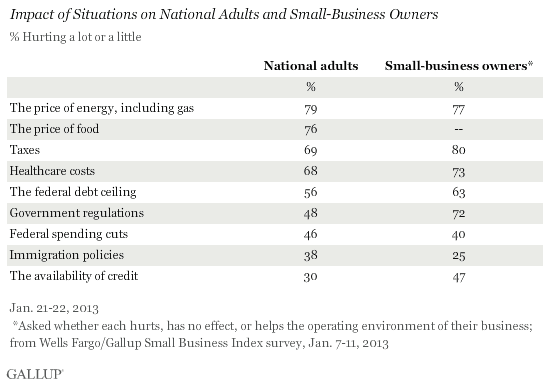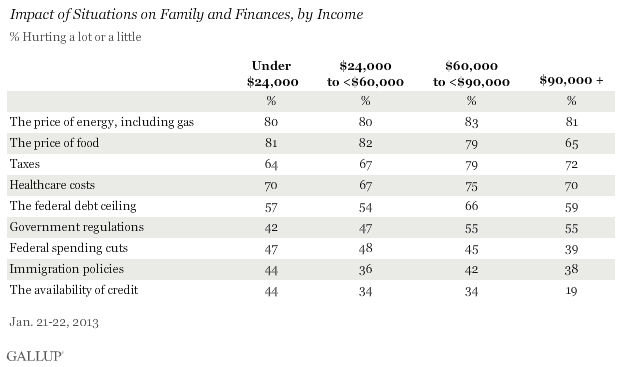PRINCETON, NJ -- Americans are most likely to say the price of energy, the price of food, taxes, and healthcare costs are hurting their family's finances a lot or a little, out of a list of nine economic issues. Americans appear relatively unaffected by the availability of credit or immigration policies.
![Now I am going to read you some possible situations that could affect your family’s finances. For each one, please say whether that situation is hurting your finances a lot, hurting your finances a little, having no effect, helping your finances a little, or helping your finances a lot. How about -- [RANDOM ORDER]? January 2013 results](http://content.gallup.com/origin/gallupinc/GallupSpaces/Production/Cms/POLL/a5ihxs47m0qevkbvv15hda.gif)
These results are from a Jan. 21-22 Gallup poll. Complete responses are available on page 2.
In addition to energy, food, taxes, and healthcare, the federal debt ceiling is the only other situation that more than half of Americans say is hurting them financially. This relatively high level of negativity about the debt ceiling is partly attributable to the views of Republicans, 74% of whom say it is hurting their finances, compared with 54% of independents and 48% of Democrats. This is not surprising; Republicans are more likely to name the deficit as the nation's most important problem than any other issue.
Eight of the nine items on the list were also included in a separate Wells Fargo/Gallup Small Business Index survey, in which small-business owners were asked if each helped or hurt the operating environment of their business (business owners were not asked about the cost of food). The items that topped the list were similar for both groups; business owners said taxes, the price of energy, and health costs were most likely to hurt their business.
At the same time, government regulations were fourth on the list for small-business owners (72% said they hurt their business a lot or a little), but sixth on the list for consumers (48%). Both consumers and business owners put immigration policies and federal spending cuts at the bottom of the "hurtful" list.

Low-Income Americans More Likely Than Those With High Incomes to See Food Prices as Hurting a Lot
Americans with incomes under $24,000 a year rate the direct costs of food, energy, and healthcare as most hurtful to their family's finances. Those with incomes of $90,000 or more have a slightly different rank order, rating energy prices as most hurtful, followed by taxes, healthcare costs, and then food prices.
The availability of credit and federal spending cuts are less hurtful to those with high incomes than to those with low incomes. On the other hand, high-income Americans are more likely to view government regulations as harmful to their family finances.

Implications
These results provide clear insights into the areas that are causing Americans the most financial pain. Leaders, including elected representatives, may find that actions aimed at reducing the costs of life necessities -- energy, food, and healthcare, along with reducing taxes -- could have the greatest impact on Americans' financial situations. Actions on things the government or its agencies have more direct control over -- credit, immigration, federal spending, and regulations -- would apparently have less of a direct impact on Americans' family finances, although over half of Americans say one thing the government can control, the federal debt ceiling, currently hurts their family's finances.
Survey Methods
Results for this Gallup poll are based on telephone interviews conducted Jan. 21-22, 2013, on the Gallup Daily tracking survey, with a random sample of 1,016 adults, aged 18 and older, living in all 50 U.S. states and the District of Columbia.
For results based on the total sample of national adults, one can say with 95% confidence that the maximum margin of sampling error is ±4 percentage points.
Interviews are conducted with respondents on landline telephones and cellular phones, with interviews conducted in Spanish for respondents who are primarily Spanish-speaking. Each sample of national adults includes a minimum quota of 50% cell phone respondents and 50% landline respondents, with additional minimum quotas by region. Landline telephone numbers are chosen at random among listed telephone numbers. Cell phones numbers are selected using random digit dial methods. Landline respondents are chosen at random within each household on the basis of which member had the most recent birthday.
Samples are weighted to correct for unequal selection probability, nonresponse, and double coverage of landline and cell users in the two sampling frames. They are also weighted to match the national demographics of gender, age, race, Hispanic ethnicity, education, region, population density, and phone status (cellphone only/landline only/both, cellphone mostly, and having an unlisted landline number). Demographic weighting targets are based on the March 2012 Current Population Survey figures for the aged 18 and older U.S. population. Phone status targets are based on the July-December 2011 National Health Interview Survey. Population density targets are based on the 2010 census. All reported margins of sampling error include the computed design effects for weighting.
In addition to sampling error, question wording and practical difficulties in conducting surveys can introduce error or bias into the findings of public opinion polls.
View methodology, full question results, and trend data.
For more details on Gallup's polling methodology, visit www.gallup.com.
![Now I am going to read you some possible situations that could affect your family’s finances. For each one, please say whether that situation is hurting your finances a lot, hurting your finances a little, having no effect, helping your finances a little, or helping your finances a lot. How about -- [RANDOM ORDER]? January 2013 full results](http://content.gallup.com/origin/gallupinc/GallupSpaces/Production/Cms/POLL/euic_rq2pewm3xhxtz4n-a.gif)
